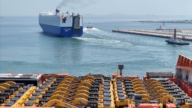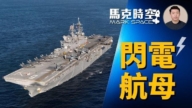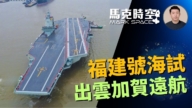【新唐人2014年05月20日訊】5月20號中國和俄羅斯開始第三次聯合軍事演習。大陸軍方聲明,演習不針對第三方,而官方媒體卻報導﹕聯合軍演「意味著俄支持我東海識別區」,「可震懾周邊國家」等。中、俄為甚麼要聯合進行軍事演習?亞洲其他鄰國會受到甚麼影響?請看專家的分析。
5月20號到26號,中、俄將在長江口以東的東海北部舉行聯合軍事演習,雙方共派出14艘水面艦艇、2艘潛艇、9架固定翼飛機,以及2個特戰分隊和6架艦載直升機。據報導,今年的軍演特點是:首次全部混編參演艦艇,首次組織潛艇和水面艦艇自主對抗﹔以及首次組織水面艦艇編隊,進行超視距攻防演練。
大陸軍方日前聲明,聯合軍演不針對第三方,是一次例行的防禦性演習。而中共官方媒體19號發文說﹕「中、俄軍演將演練敏感課目,意味著俄支持我東海識別區。」
美國《中國事務》雜誌總編輯伍凡:「從中國來講,它現在面臨的是東海和南海有強大的壓力,是美國要重返亞太、戰略再平衡,它支持日本、菲律賓和越南。最近發生中、越邊境鑽井平臺的事件,美國一再講(是)中國的挑釁。那麼在這個時候,中國(中共)需要找另外一個朋友來幫架。」
今年是中、俄聯合軍事演習的第三年,大陸媒體宣稱這「已經成為中俄兩國海軍常態化、機制化的合作形式」。以往,中、俄軍演期間,大陸有媒體網站開設專頁,高調報導。
旅美時事評論員藍述:「中共來講,由於它國內的目前尖銳的社會矛盾,為了轉移中國社會的視線,不斷挑起亞洲周邊國家的緊張關係,包括越南,菲律賓,日本等等。所以說,在亞州它也相當的孤立。在這種情況之下,雙方結盟,是互相之間兩個政權維持自己統治穩定的這麼一種需要。」
5月初,北京宣佈,「中海油」981號鑽油平臺,將移到南海西沙群島附近鑽探,直到8月。由於中國的鑽油平臺距離越南海岸線僅120海浬,越南堅稱那裏是他們的經濟海域,因此立即引起越南的抗議,雙方數十艘船艇在鑽探現場發生衝突碰撞。隨後美國公開批評中共。
美國中文雜誌《中國事務》總編輯伍凡分析,中、俄聯合軍演,是中共對亞洲鄰國使用的一種心理戰術。
伍凡:「首先輿論壓力了或者一種精神壓力了。我還沒有說我要跟你們打,我就站在那裏,直接就是心理壓力。實際上這個東西是一種很深的一個心理戰。」
今年中、俄的軍演,雙方共派出軍艦16艘,比去年的19艘略少,但官方媒體說,專業特性艦艇相對集中,是艦隊級、高性能的作戰艦艇。
藍述:「這種軍事同盟上的進一步升級,讓越來越多的亞州國家感到不安,對北京持有越來越大的戒備心理,包括中共一直稱為『中共的老朋友』的李光耀都公開要求:美國回到亞太地區,去平衡由於中共的崛起,造成亞洲太平洋地區力量的不均衡。」
軍演中被外界關注的是大型登陸艦。大陸官方的軍事專家介紹,登陸艦主要用於島礁攻防上,可震懾周邊國家,因為在東南沿海都存在島礁攻防的問題。
藍述:「因為只有通過和美國更緊密的結盟,它才能夠平衡來自於中、俄的這一種壓力。所以中、俄走得越來越近,直接造成的後果就是﹕亞州太平洋地區的這些中國鄰近的周邊國家,和美國之間的結盟會越來越緊密。」
中共官方軍事網站還宣稱,中、俄聯手「改變了未來軍事關係的新風向。」伍凡表示,中、俄雖然目前表面合作,但未來是否真的會同時行動,那還「不一定」。
採訪編輯/唐音 後製/孫寧
The Political Significance of the Sino-Russian Joint Military Drill
China and Russia are to begin their third joint military drill
on May 20.
While the Chinese military claimed the exercise was not
targeted at a third party, official media reported the drill
signals Russia’s support of China’s East China Sea Air
Identification Zone as a deterrent to neighboring countries.
What is the purpose of the Sino-Russia joint military drill?
How will other Asian countries be affected?
Please follow our experts’ analysis.
China will conduct a joint naval drill with Russia between
May 20 and 26 in the northern part of the East China Sea
off of the Yangtze River.
A total of 14 surface ships, two submarines, nine fixed-wing
war planes, six shipboard helicopters and two operational
detachment-alphas (ODAs) from both navies
will join the exercises
Reportedly, in contrast to previous China-Russia sea joint
drills, the two sides will combine all warships together
for the first time, submarines and warships will be arranged
to fight automatically for the first time, and the ships
will carry out battle exercises beyond visibility
for the first time.
The Chinese navy said that the drill was not targeted
at a third party, but is a routine defense exercise.
The regime media reported, “While the Sino-Russia joint
exercise targets sensitive subjects, it also signals Russia’s
support to China’s East China Sea Identification Zone."
Chris Wu, editor-in-chief of China Affairs magazine:
“China is strongly pressured in both East China Sea
and South China Sea, due to the rebalancing strategy
with the United States’ return to Asia to support Japan,
Philippines and Vietnam.
The U.S. Department of State referred to recent conflicts
regarding the oil rig between the CCP and Vietnamese
vessels as ‘provocative’ act by the CCP.
The regime is looking for a supporter."
Mainland media said that the drills, now in their third round,
are regular and routine exercises by China and Russia.
Websites have also been created specifically for reporting
on the drills in a high profile fashion.
Lan Su, commentator: “The Communist China has constantly
stirred up tensions with neighboring countries such as
Vietnam, Philippines, and Japan in order to divert
its domestic conflicts.
Being isolated in Asia, the alliance between the two
is to maintain stability for both regimes."
In early May, Beijing announced that oil rig No. 981
will begin drilling near the Paracel Islands
in the South China Sea until August.
Located just 120 nautical miles off Vietnam’s coast line,
the rig is commonly believed to be an invasion
of Vietnamese economic waters.
Protests broke out in Vietnam.
A few dozen boats from both sides collided in conflict
around the drilling site, followed
by the United States’ public condemnation of China.
China Affairs magazine editor-in-chief Chris Wu analyzes
that the joint naval drill is psychological warfare
by the Communist China against its neighboring
Asian countries.
Chris Wu: “It is like public pressure or psychological stress
before the real war.
In fact, it’s deep psychological warfare."
The total of 16 participating warships from both Russia
and China this year are less than last year’s 19.
However, official media commented that the ships being used
are composed of high-performance, fleet-level
relatively concentrated warships.
Lan Su: “This further escalation of the military alliance
puts many countries in growing concern and wariness.
Even the old friend of the CCP, Singaporean Lee Kuan Yew,
has called on the U.S. to return to Asia-Pacific region.
There is a need to balance the uprising power of the CCP
in the area."
What’s concerning about this military exercise is the presence
of a large landing craft.
The Chinese military expert had introduced the landing craft,
mainly used for combating on reefs, can deter neighboring
countries where coastal reefs are frequently seen in the
southeast coastal region.
Lan Su: “Only with a closer alliance with the United States
will the pressure of Sino-Russia be balanced.
The close relationship between China and Russia will directly
bring the neighboring countries in Asia form a tighter alliance
with the U.S."
Communist China’s official military website also claimed
that the collaboration between Russia and China
“changes military relations in a new direction."
Chris Wu indicates the collaboration between China and
Russia does ‘not necessarily’ guarantee a future collaboration.
Interview & Edit/Tang Yin Post-Production/Sun Ning





























